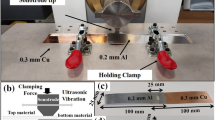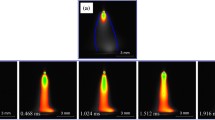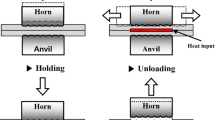Abstract
Ultrasonic welding has become a key joining approach in batteries and energy vehicles. This work reports the optimization in static property and stability of self-piercing riveting joints which is becoming the most versatile way to join microstructures. Tool heads of three different knurling profiles (e.g., A, B, and C) are used to perform ultrasonic composite with riveting. Based on tensile-shear tests, SEM, EDS, XRD, and Vickers microhardness analysis were conducted to investigate the comparative study of the fracture morphology, element distribution, phase structure, and hardness. The results indicated that all three types of knurling generate solid phase welding at the sheet joints. Thus, it improved the forming quality and mechanical properties of self-piercing riveting joints. The C-shaped welding tool head has advantageous effect on optimizing the mechanical properties of joints. Further, it enhanced the average peak load by 25.6%, the average failure displacement by 31.1%, and the average energy absorption by 88.8%. The microscopic results showed that a large amount of oxides are precipitated at the edge of welding joints when the B-shape knurling tool is used. The distribution of the hardness value of joints horizontal line is “M” shape. Besides, the coarse grains in the joint area and the interplanar space increase significantly after ultrasonic welding which softens the sheet.









Similar content being viewed by others
References
Ang HQ (2021) An overview of self-piercing riveting process with focus on joint failures, corrosion issues and optimisation techniques. Chinese J Mech Eng (English Ed) 34. https://doi.org/10.1186/s10033-020-00526-3
Haque R (2018) Quality of self-piercing riveting (SPR) joints from cross-sectional perspective: a review. Arch Civ Mech Eng 18:83–93. https://doi.org/10.1016/j.acme.2017.06.003
Rusia A, Weihe S (2020) Development of an end-to-end simulation process chain for prediction of self-piercing riveting joint geometry and strength. J Manuf Process 57:519–532. https://doi.org/10.1016/j.jmapro.2020.07.004
Liang J, Jiang H, Zhang J, Wu X, Zhang X, Li G, Cui J (2019) Investigations on mechanical properties and microtopography of electromagnetic self-piercing riveted joints with carbon fiber reinforced plastics/aluminum alloy 5052. Arch Civ Mech Eng 19:240–250. https://doi.org/10.1016/j.acme.2018.11.001
Wu J, Chen C, Ouyang Y (2021) Recent development of the novel riveting processes. Int J Adv Manuf Technol 117:19–47. https://doi.org/10.1007/s00170-021-07689-w
Moroni F (2019) Fatigue behaviour of hybrid clinch-bonded and self-piercing rivet bonded joints. J Adhes 95:577–594. https://doi.org/10.1080/00218464.2018.1552586
Xian X, Ma Y, Shan H, Niu S, Li Y (2019) Single-sided joining of aluminum alloys using friction self-piercing riveting (F-SPR) process. J Manuf Process 38:319–327. https://doi.org/10.1016/j.jmapro.2019.01.037
Wang D, Abbas Z, Du Z, Du Z, Lu L, Zhao K, Zhao X, Yuan Y, Zong H, Cui Y, Sou L, Liang J (2022) Phase field simulation of electrohydrodynamic jet droplets and printing microstructures on insulating substrates. Microelectron Eng 261:111817. https://doi.org/10.1016/j.mee.2022.111817
Zhang X, He X, Xing B, Wei W (2020) Pre-holed self-piercing riveting of carbon fibre reinforced polymer laminates and commercially pure titanium sheets. J Mater Process Technol 279:116550. https://doi.org/10.1016/j.jmatprotec.2019.116550
Zhao X, Meng D, Zhang J, Han Q (2020) The effect of heat treatment on die casting aluminum to apply self-pierce riveting. Int J Adv Manuf Technol 109:2409–2419. https://doi.org/10.1007/s00170-020-05833-6
Zhang Y, Yi R, Wang P, Fu C, Cai N, Ju J (2021) Self-piercing riveting of hot stamped steel and aluminum alloy sheets base on local softening zone. Steel Res Int 92:1–8. https://doi.org/10.1002/srin.202000535
Alves LM, Afonso RM, Martins PAF (2021) Double-sided self-pierce riveting of polymer sheets. J Adv Join Process 3:100051. https://doi.org/10.1016/j.jajp.2021.100051
Huang Z, Yao Q, Lai J, Abbas Z (2017) Developing a self-piercing riveting with flange pipe rivet joining aluminum sheets. Int J Adv Manuf Technol 91:2315–2328. https://doi.org/10.1007/s00170-016-9938-9
Liu Y, He X, Deng C (2017) Self-piercing riveting of metal foam sandwich structures. Mater Trans 58:1532–1537. https://doi.org/10.2320/matertrans.M2017187
Ying L, Gao T, Dai M, Hu P, Dai J (2021) Towards joinability of thermal self-piercing riveting for AA7075-T6 aluminum alloy sheets under quasi-static loading conditions. Int J Mech Sci 189:105978. https://doi.org/10.1016/j.ijmecsci.2020.105978
Karim MA, Jeong TE, Noh W, Park K, Kam D, Kim C, Nam D, Jung H, Park Y (2020) Joint quality of self-piercing riveting (SPR) and mechanical behavior under the frictional effect of various rivet coatings. J Manuf Process 58:466–477. https://doi.org/10.1016/j.jmapro.2020.08.038
Van Hall SN, Findley KO, Freis AK (2018) Improved self-pierce rivet performance through intentional decarburization. J Mater Process Technol 251:350–359. https://doi.org/10.1016/j.jmatprotec.2017.08.018
Ma YW, Lou M, Li YB, Lin ZQ (2018) Effect of rivet and die on self-piercing rivetability of AA6061-T6 and mild steel CR4 of different gauges. J Mater Process Technol 251:282–294. https://doi.org/10.1016/j.jmatprotec.2017.08.020
Xie Z, Zhang W, Chen T, Zhou D, Shi L, Tang Y, Yu C (2021) Comparative analysis and design method of shear strength for hybrid SPR-SDS joints in thin-walled steel structures. Structures 33:4313–4329. https://doi.org/10.1016/j.istruc.2021.07.003
Li D (2017) Influence of local surface texture by tool impression on the self-piercing riveting process and the static lap shear strength. J Manuf Process 29:298–309. https://doi.org/10.1016/j.jmapro.2017.08.003
Nambu S, Seto K, Lin JY, Koseki T (2018) Development of a bonding interface between steel/steel and steel/Ni by ultrasonic welding. Sci Technol Weld Join 23:687–692. https://doi.org/10.1080/13621718.2018.1473077
Guo N, Fu Y, Wang Y, Meng Q, Zhu Y (2017) Microstructure and mechanical properties in friction stir welded 5A06 aluminum alloy thick plate. Mater Des 113:273–283. https://doi.org/10.1016/j.matdes.2016.10.030
Lei Z, Bi J, Li P, Tao G, Yaobang Z, Dengming Z (2018) Analysis on welding characteristics of ultrasonic assisted laser welding of AZ31B magnesium alloy. Opt Laser Technol 105:15–22. https://doi.org/10.1016/j.optlastec.2018.02.050
Cai J, Wang Y, Jiang D, Gu Y, Lou L, Gao F, Wu A (2023) Photoacoustic imaging based on AlN MF-PMUT with broadened bandwidth. IEEE Sensors Letters 1:1–5. https://doi.org/10.1109/LSENS.2023.3254593
Pop F, Herrera B, Rinaldi M (2022) Lithium niobate piezoelectric micromachined ultrasonic transducers for high data-rate intrabody communication. Nat Commun 13:1–12. https://doi.org/10.1038/s41467-022-29355-9
Jung J, Lee W, Kang W, Shin E, Ryu J, Choi H (2017) Review of piezoelectric micromachined ultrasonic transducers and their applications. J Micromech Microeng 27. https://doi.org/10.1088/1361-6439/aa851b
Funding
This research is supported by National Natural Science Foundation of China (Grant No. 12104324); Postdoctoral Science Foundation of China (No. 2021M703392); Scientific Research Startup Fund for Shenzhen High-Caliber Personnel of SZPT (No.6022310046K); Postdoctoral Startup Fund of Shenzhen Polytechnic University (No. 6021330001K and No. 6022331008K).
Author information
Authors and Affiliations
Contributions
Authors have notable contributions for the preparation of this manuscript.
Corresponding author
Ethics declarations
Ethical approval
Not applicable.
Consent to participate
All authors agreed to participate in this work.
Consent for publication
All authors are agreed for publication of this work.
Competing interests
The authors declare no competing interests.
Additional information
Publisher’s Note
Springer Nature remains neutral with regard to jurisdictional claims in published maps and institutional affiliations.
Rights and permissions
Springer Nature or its licensor (e.g. a society or other partner) holds exclusive rights to this article under a publishing agreement with the author(s) or other rightsholder(s); author self-archiving of the accepted manuscript version of this article is solely governed by the terms of such publishing agreement and applicable law.
About this article
Cite this article
Zixin, G., Zhao, L., Abbas, Z. et al. The effects of three profiles on the mechanical properties and grain size of self-piercing riveting joints using ultrasonic welding. Int J Adv Manuf Technol 129, 4869–4882 (2023). https://doi.org/10.1007/s00170-023-12567-8
Received:
Accepted:
Published:
Issue Date:
DOI: https://doi.org/10.1007/s00170-023-12567-8




